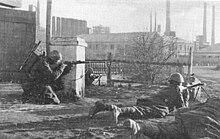Corpo di spedizione italiano in Russia
The Corpo di spedizione italiano in Russia ( German Italian Expeditionary Corps in Russia, CSIR ) was an Italian army corps in World War II . It was set up on July 10, 1941. On July 9, 1942, it was renamed XXXV Corpo d'armata ( German XXXV. Army Corps ) and incorporated into the newly established Italian 8th Army . The expedition corps operated from August 1941 to July 1942 with German units of Army Group South in the Ukraine .
Formation history
The CSIR essentially emerged from the (XXXV.) (Partially) motorized corps set up in Cremona in 1939 . In addition to the 9th Infantry Division Pasubio and the 52nd Infantry Division Torino , it received the 3rd Rapid Division Principe Amedeo Duca d'Aosta . The infantry divisions were two-part divisions with only two infantry regiments and one artillery regiment. With around 10,000 men each, they were smaller and weaker than the infantry divisions of the Wehrmacht . Since the number of vehicles was not enough to move both divisions at the same time, they were mostly concentrated in the Pasubio division , which was therefore able to keep up with the German troop movements. The 3rd Rapid Division was a hybrid formation of around 7,500 men with two cavalry regiments , a Bersaglieri regiment , a light tank division with 60 tankettes of the L3 / 33 type and a drawn artillery regiment . In March 1942, the rapid division lost the cavalry regiments Savioia Cavalleria and Lancieri di Novara as well as their drawn artillery regiment, with which a mounted combat group was formed (Raggruppamento Truppe a Cavallo) . In return for the remaining 3rd, they received the 6th Bersaglieri Regiment, the 120th Motorized Artillery Regiment and a new tank division on L6 / 40 . The 3rd fast division was now considered a motorized division.
The corps troops included the 63rd Motorized Legion Tagliamento , an association of the fascist militia consisting of three battalions , and the 30th corps artillery association with five departments and anti-aircraft units. In total, the expedition corps consisted of 62,000 men with 220 guns, 92 anti-tank guns and 5,500 motor vehicles. The CSIR also included units of the Italian Air Force with a total of 83 aircraft. As commanding general was Francesco Zingales provided. Zingales fell ill when the corps was transferred to the Soviet Union in Vienna and was replaced by General Giovanni Messe . After the CSIR in July 1942 as XXXV. Corps was integrated into the 8th Army, Messe remained at its head until the beginning of November 1942, when he gave the post to Zingales.
Mission history
Four weeks after the start of the German-Soviet War , the CSIR was relocated to the Eastern Front. After being transported by rail to Máramarossziget , Felsővisó and Borșa , it crossed the Carpathian Mountains on its own and gathered at Botoșani until August 5, 1941 . As a reserve of the German 11th Army of Army Group South , the CSIR received the order to move to Jampol on the Dniester , which at first only the Pasubio Division with its Lancia 3Ro succeeded in the required speed. From there, the division and German units advanced towards the mouth of the Bug to cut off the retreat of Soviet units. In the battle near Jasna Poljana, the division was able to prevail. On August 14, 1941, the CSIR was subordinated to Panzer Group 1 , covered its left flank and thus cleared German divisions for the attacking front.
At the beginning of September 1941, the CSIR took over an approximately 150 km long section of the front near Dnepropetrovsk . There it was commissioned to encircle Soviet units between the Orel River and the Dnepropetrovsk bridgehead with a pincer movement on Petrikowa . In the operation, which was completed on September 30, 1941, the CSIR took around 10,000 prisoners. It also facilitated the advance of the 17th Army on Poltava .
When Panzer Group 1, now 1st Panzer Army, advanced on Rostov and the Donets Basin in October , the CSIR again took over the security of the left flank. It supported an attack on Pavlograd . Together with the German XXXXIX. The CSIR mountain corps captured the industrial area of Stalino on October 20, 1941 . The Bersaglieri of the fast division distinguished themselves in the capture of the Stalino station and on November 1st in the capture of Rykowo . After the capture of Gorlwoka a few kilometers to the north, at Nikitowka, the Pasubio division was involved in heavy fighting.
In the early morning of December 25, 1941, a Soviet attack on the CSIR began, which Stalino was able to hold and then, with German support, recaptured lost terrain. At the end of January 1942, a CSIR combat group moved to Isjum , around 100 km north of Gorlowka, where it supported German units of the 17th Army until May 1942. The rest of the Italian corps remained in the Stalino area in the spring, where it was partially reclassified and reinforced. On June 3, 1942 it was subordinated to the German 17th Army, and on July 9th to the newly formed Italian 8th Army .
literature
- Thomas Schlemmer (Ed.): The Italians on the Eastern Front 1942/43. Documents on Mussolini's war against the Soviet Union , Oldenbourg, 2005, ISBN 978-3-486-70284-2 .
- Giovanni Messe (Commander in Chief of the CSIR): The War in the East. , Übers. Ad Ital., With 12 sketches, Zurich, Thomas-Verlag, 1948.
Web links
- Presentation on regioesercito.it
- Structure in August 1941 on niehorster.org



